7.7: Modeling with Quadratic Functions
- Page ID
- 93930
- Recognize characteristics of parabolas
- Understand how the graph of a parabola is related to its quadratic function
- Solve problems involving a quadratic function’s minimum or maximum value
in order to apply mathematical modeling to solve real-world applications.
Curved antennas, such as the ones shown in Figure \(\PageIndex{1}\), are commonly used to focus microwaves and radio waves to transmit television and telephone signals, as well as satellite and spacecraft communication. The cross-section of the antenna is in the shape of a parabola, which can be described by a quadratic function.

Figure \(\PageIndex{1}\): An array of satellite dishes. (credit: Matthew Colvin de Valle, Flickr)
In this section, we will investigate quadratic functions, which frequently model problems involving area and projectile motion. Working with quadratic functions can be less complex than working with higher degree functions, so they provide a good opportunity for a detailed study of function behavior.
Recognizing Characteristics of Parabolas
The graph of a quadratic function is a U-shaped curve called a parabola. One important feature of the graph is that it has an extreme point, called the vertex. If the parabola opens up, the vertex represents the lowest point on the graph, or the minimum value of the quadratic function. If the parabola opens down, the vertex represents the highest point on the graph, or the maximum value. In either case, the vertex is a turning point on the graph. The graph is also symmetric with a vertical line drawn through the vertex, called the axis of symmetry. These features are illustrated in Figure \(\PageIndex{2}\).
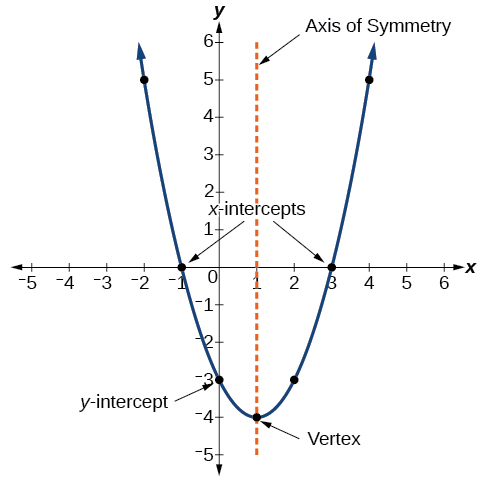
The y-intercept is the point at which the parabola crosses the \(y\)-axis. The x-intercepts are the points at which the parabola crosses the \(x\)-axis. If they exist, the x-intercepts represent the zeros, or roots, of the quadratic function, the values of \(x\) at which \(y=0\).
Determine the vertex, axis of symmetry, zeros, and y-intercept of the parabola shown in Figure \(\PageIndex{3}\).
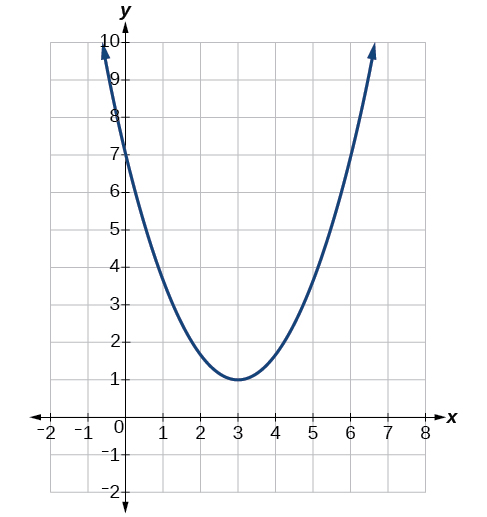
Solution
The vertex is the turning point of the graph. We can see that the vertex is at \((3,1)\). Because this parabola opens upward, the axis of symmetry is the vertical line that intersects the parabola at the vertex. So the axis of symmetry is \(x=3\). This parabola does not cross the x-axis, so it has no zeros. It crosses the \(y\)-axis at \((0,7)\) so this is the y-intercept.
Understanding How the Graphs of Parabolas are Related to Their Quadratic Functions
The general form of a quadratic function presents the function in the form
\[f(x)=ax^2+bx+c\]
where \(a\), \(b\), and \(c\) are real numbers and \(a{\neq}0\). If \(a>0\), the parabola opens upward. If \(a<0\), the parabola opens downward. We can use the general form of a parabola to find the equation for the axis of symmetry.
The axis of symmetry is defined by \(x=−\frac{b}{2a}\). If we use the quadratic formula, \(x=\frac{−b{\pm}\sqrt{b^2−4ac}}{2a}\), to solve \(ax^2+bx+c=0\) for the x-intercepts, or zeros, we find the value of \(x\) halfway between them is always \(x=−\frac{b}{2a}\), the equation for the axis of symmetry.
Figure \(\PageIndex{4}\) represents the graph of the quadratic function written in general form as \(y=x^2+4x+3\). In this form, \(a=1\), \(b=4\), and \(c=3\). Because \(a>0\), the parabola opens upward. The axis of symmetry is \(x=−\frac{4}{2(1)}=−2\). This also makes sense because we can see from the graph that the vertical line \(x=−2\) divides the graph in half. The vertex always occurs along the axis of symmetry. For a parabola that opens upward, the vertex occurs at the lowest point on the graph, in this instance, \((−2,−1)\). The x-intercepts, those points where the parabola crosses the x-axis, occur at \((−3,0)\) and \((−1,0)\).
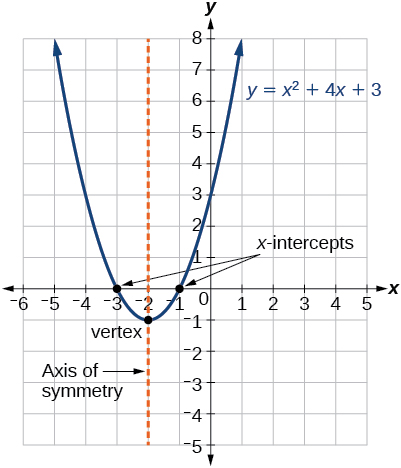
The standard form of a quadratic function presents the function in the form
\[f(x)=a(x−h)^2+k\]
where \((h, k)\) is the vertex. Because the vertex appears in the standard form of the quadratic function, this form is also known as the vertex form of a quadratic function.
As with the general form, if \(a>0\), the parabola opens upward and the vertex is a minimum. If \(a<0\), the parabola opens downward, and the vertex is a maximum. Figure \(\PageIndex{5}\) represents the graph of the quadratic function written in standard form as \(y=−3(x+2)^2+4\). Since \(x–h=x+2\) in this example, \(h=–2\). In this form, \(a=−3\), \(h=−2\), and \(k=4\). Because \(a<0\), the parabola opens downward. The vertex is at \((−2, 4)\).
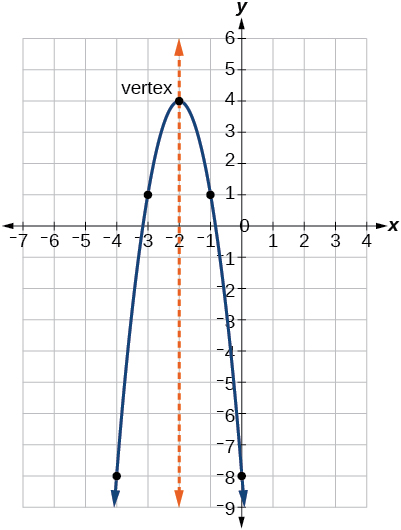
The standard form is useful for determining how the graph is transformed from the graph of \(y=x^2\). Figure \(\PageIndex{6}\) is the graph of this basic function.
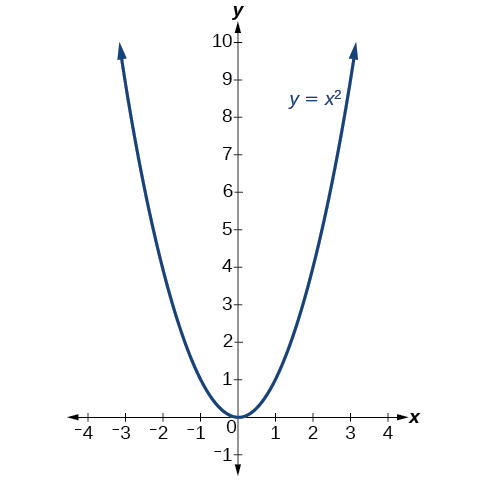
If \(k>0\), the graph shifts upward, whereas if \(k<0\), the graph shifts downward. In Figure \(\PageIndex{5}\), \(k>0\), so the graph is shifted 4 units upward. If \(h>0\), the graph shifts toward the right and if \(h<0\), the graph shifts to the left. In Figure \(\PageIndex{5}\), \(h<0\), so the graph is shifted 2 units to the left. The magnitude of \(a\) indicates the stretch of the graph. If \(|a|>1\), the point associated with a particular x-value shifts farther from the x-axis, so the graph appears to become narrower, and there is a vertical stretch. But if \(|a|<1\), the point associated with a particular x-value shifts closer to the x-axis, so the graph appears to become wider, but in fact there is a vertical compression. In Figure \(\PageIndex{5}\), \(|a|>1\), so the graph becomes narrower.
The standard form and the general form are equivalent methods of describing the same function. We can see this by expanding out the general form and setting it equal to the standard form.
\[\begin{align*} a(x−h)^2+k &= ax^2+bx+c \\[4pt] ax^2−2ahx+(ah^2+k)&=ax^2+bx+c \end{align*} \]
For the linear terms to be equal, the coefficients must be equal.
\[–2ah=b \text{, so } h=−\dfrac{b}{2a}. \nonumber\]
This is the axis of symmetry we defined earlier. Setting the constant terms equal:
\[\begin{align*} ah^2+k&=c \\ k&=c−ah^2 \\ &=c−a−\Big(\dfrac{b}{2a}\Big)^2 \\ &=c−\dfrac{b^2}{4a} \end{align*}\]
In practice, though, it is usually easier to remember that \(k\) is the output value of the function when the input is \(h\), so \(f(h)=k\).
A quadratic function is a function of degree two. The graph of a quadratic function is a parabola.
- The general form of a quadratic function is \(f(x)=ax^2+bx+c\) where \(a\), \(b\), and \(c\) are real numbers and \(a{\neq}0\).
- The standard form of a quadratic function is \(f(x)=a(x−h)^2+k\).
- The vertex \((h,k)\) is located at \[h=–\dfrac{b}{2a},\;k=f(h)=f(\dfrac{−b}{2a}).\]
Given a graph of a quadratic function, write the equation of the function in general form.
- Identify the horizontal shift of the parabola; this value is \(h\). Identify the vertical shift of the parabola; this value is \(k\).
- Substitute the values of the horizontal and vertical shift for \(h\) and \(k\). in the function \(f(x)=a(x–h)^2+k\).
- Substitute the values of any point, other than the vertex, on the graph of the parabola for \(x\) and \(f(x)\).
- Solve for the stretch factor, \(|a|\).
- If the parabola opens up, \(a>0\). If the parabola opens down, \(a<0\) since this means the graph was reflected about the x-axis.
- Expand and simplify to write in general form.
Write an equation for the quadratic function \(g\) in Figure \(\PageIndex{7}\) as a transformation of \(f(x)=x^2\), and then expand the formula, and simplify terms to write the equation in general form.
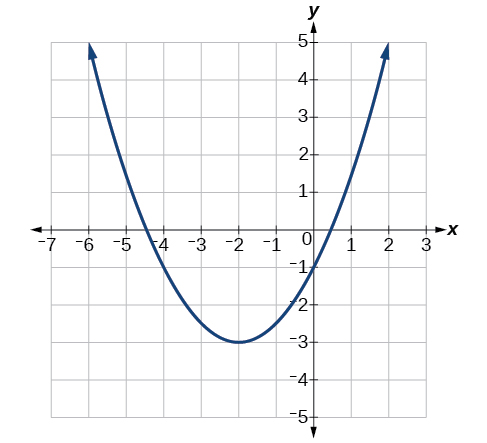
Solution
We can see the graph of \(g\) is the graph of \(f(x)=x^2\) shifted to the left 2 and down 3, giving a formula in the form \(g(x)=a(x+2)^2–3\).
Substituting the coordinates of a point on the curve, such as \((0,−1)\), we can solve for the stretch factor.
\[\begin{align} −1&=a(0+2)^2−3 \\ 2&=4a \\ a&=\dfrac{1}{2} \end{align}\]
In standard form, the algebraic model for this graph is \(g(x)=\dfrac{1}{2}(x+2)^2–3\).
To write this in general polynomial form, we can expand the formula and simplify terms.
\[\begin{align} g(x)&=\dfrac{1}{2}(x+2)^2−3 \\ &=\dfrac{1}{2}(x+2)(x+2)−3 \\ &=\dfrac{1}{2}(x^2+4x+4)−3 \\ &=\dfrac{1}{2}x^2+2x+2−3 \\ &=\dfrac{1}{2}x^2+2x−1 \end{align}\]
Notice that the horizontal and vertical shifts of the basic graph of the quadratic function determine the location of the vertex of the parabola; the vertex is unaffected by stretches and compressions.
Analysis
We can check our work using the table feature on a graphing utility. First enter \(\mathrm{Y1=\dfrac{1}{2}(x+2)^2−3}\). Next, select \(\mathrm{TBLSET}\), then use \(\mathrm{TblStart=–6}\) and \(\mathrm{ΔTbl = 2}\), and select \(\mathrm{TABLE}\). See Table \(\PageIndex{1}\)
| \(x\) | -6 | -4 | -2 | 0 | 2 |
|---|---|---|---|---|---|
| \(y\) | -5 | -1 | -3 | -1 | 5 |
The ordered pairs in the table correspond to points on the graph.
A coordinate grid has been superimposed over the quadratic path of a basketball in Figure \(\PageIndex{8}\). Find an equation for the path of the ball. Does the shooter make the basket?
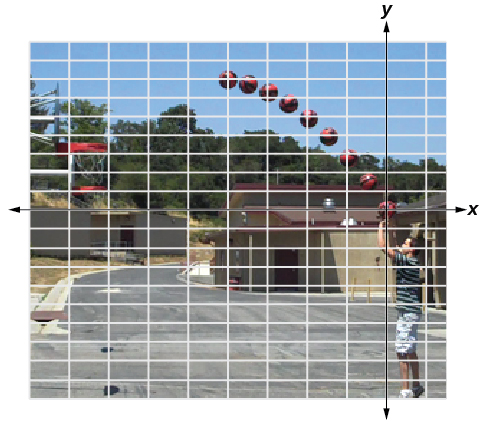
Figure \(\PageIndex{8}\): Stop motioned picture of a boy throwing a basketball into a hoop to show the parabolic curve it makes.
(credit: modification of work by Dan Meyer)
- Answer
-
The path passes through the origin and has vertex at \((−4, 7)\), so \(h(x)=–\frac{7}{16}(x+4)^2+7\). To make the shot, \(h(−7.5)\) would need to be about 4 but \(h(–7.5){\approx}1.64\); he doesn’t make it.
![]() Given a quadratic function in general form, find the vertex of the parabola.
Given a quadratic function in general form, find the vertex of the parabola.
- Identify \(a\), \(b\), and \(c\).
- Find \(h\), the x-coordinate of the vertex, by substituting \(a\) and \(b\) into \(h=–\frac{b}{2a}\).
- Find \(k\), the y-coordinate of the vertex, by evaluating \(k=f(h)=f\Big(−\frac{b}{2a}\Big)\).
Find the vertex of the quadratic function \(f(x)=2x^2–6x+7\). Rewrite the quadratic in standard form (vertex form).
Solution
The horizontal coordinate of the vertex will be at
\[\begin{align} h&=–\dfrac{b}{2a} \\ &=-\dfrac{-6}{2(2)} \\ &=\dfrac{6}{4} \\ &=\dfrac{3}{2}\end{align}\]
The vertical coordinate of the vertex will be at
\[\begin{align} k&=f(h) \\ &=f\Big(\dfrac{3}{2}\Big) \\ &=2\Big(\dfrac{3}{2}\Big)^2−6\Big(\dfrac{3}{2}\Big)+7 \\ &=\dfrac{5}{2} \end{align}\]
Rewriting into standard form, the stretch factor will be the same as the \(a\) in the original quadratic.
\[f(x)=ax^2+bx+c \\ f(x)=2x^2−6x+7\]
Using the vertex to determine the shifts,
\[f(x)=2\Big(x–\dfrac{3}{2}\Big)^2+\dfrac{5}{2}\]
Analysis
One reason we may want to identify the vertex of the parabola is that this point will inform us what the maximum or minimum value of the function is, \((k)\),and where it occurs, \((h)\).
Given the equation \(g(x)=13+x^2−6x\), write the equation in general form and then in standard form.
- Answer
-
\(g(x)=x^2−6x+13\) in general form; \(g(x)=(x−3)^2+4\) in standard form.
Determining the Maximum and Minimum Values of Quadratic Functions
The output of the quadratic function at the vertex is the maximum or minimum value of the function, depending on the orientation of the parabola. We can see the maximum and minimum values in Figure \(\PageIndex{9}\).

There are many real-world scenarios that involve finding the maximum or minimum value of a quadratic function, such as applications involving area and revenue.
A backyard farmer wants to enclose a rectangular space for a new garden within her fenced backyard. She has purchased 80 feet of wire fencing to enclose three sides, and she will use a section of the backyard fence as the fourth side.
- Find a formula for the area enclosed by the fence if the sides of fencing perpendicular to the existing fence have length \(L\).
- What dimensions should she make her garden to maximize the enclosed area?
Solution
Let’s use a diagram such as Figure \(\PageIndex{10}\) to record the given information. It is also helpful to introduce a temporary variable, \(W\), to represent the width of the garden and the length of the fence section parallel to the backyard fence.
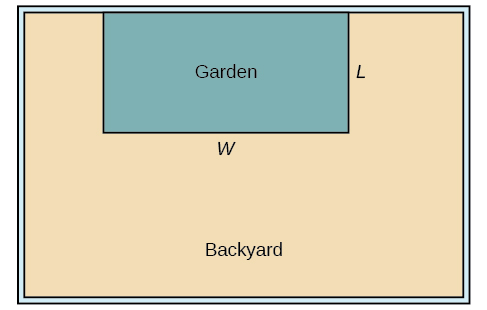
a. We know we have only 80 feet of fence available, and \(L+W+L=80\), or more simply, \(2L+W=80\). This allows us to represent the width, \(W\), in terms of \(L\).
\[W=80−2L\]
Now we are ready to write an equation for the area the fence encloses. We know the area of a rectangle is length multiplied by width, so
\[\begin{align} A&=LW=L(80−2L) \\ A(L)&=80L−2L^2 \end{align}\]
This formula represents the area of the fence in terms of the variable length \(L\). The function, written in general form, is
\[A(L)=−2L^2+80L\].
The quadratic has a negative leading coefficient, so the graph will open downward, and the vertex will be the maximum value for the area. In finding the vertex, we must be careful because the equation is not written in standard polynomial form with decreasing powers. This is why we rewrote the function in general form above. Since \(a\) is the coefficient of the squared term, \(a=−2\), \(b=80\), and \(c=0\).
To find the vertex:
\[\begin{align} h& =−\dfrac{80}{2(−2)} &k&=A(20) \\ &=20 & \text{and} \;\;\;\; &=80(20)−2(20)^2 \\ &&&=800 \end{align}\]
The maximum value of the function is an area of 800 square feet, which occurs when \(L=20\) feet. When the shorter sides are 20 feet, there is 40 feet of fencing left for the longer side. To maximize the area, she should enclose the garden so the two shorter sides have length 20 feet and the longer side parallel to the existing fence has length 40 feet.
Analysis
This problem also could be solved by graphing the quadratic function. We can see where the maximum area occurs on a graph of the quadratic function in Figure \(\PageIndex{11}\).
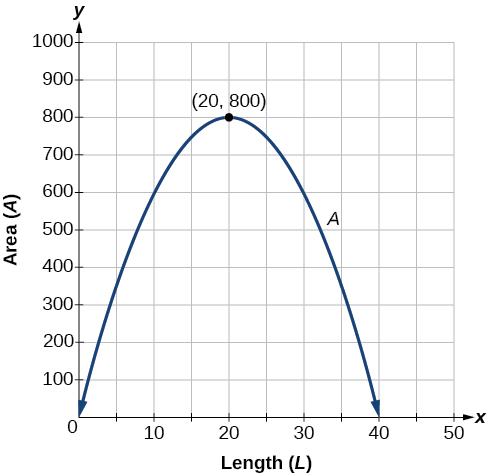
![]() Given an application involving revenue, use a quadratic equation to find the maximum.
Given an application involving revenue, use a quadratic equation to find the maximum.
- Write a quadratic equation for revenue.
- Find the vertex of the quadratic equation.
- Determine the y-value of the vertex.
The unit price of an item affects its supply and demand. That is, if the unit price goes up, the demand for the item will usually decrease. For example, a local newspaper currently has 84,000 subscribers at a quarterly charge of $30. Market research has suggested that if the owners raise the price to $32, they would lose 5,000 subscribers. Assuming that subscriptions are linearly related to the price, what price should the newspaper charge for a quarterly subscription to maximize their revenue?
Solution
Revenue is the amount of money a company brings in. In this case, the revenue can be found by multiplying the price per subscription times the number of subscribers, or quantity. We can introduce variables, \(p\) for price per subscription and \(Q\) for quantity, giving us the equation \(\text{Revenue}=pQ\).
Because the number of subscribers changes with the price, we need to find a relationship between the variables. We know that currently \(p=30\) and \(Q=84,000\). We also know that if the price rises to $32, the newspaper would lose 5,000 subscribers, giving a second pair of values, \(p=32\) and \(Q=79,000\). From this we can find a linear equation relating the two quantities. The slope will be
\[\begin{align} m&=\dfrac{79,000−84,000}{32−30} \\ &=−\dfrac{5,000}{2} \\ &=−2,500 \end{align}\]
This tells us the paper will lose 2,500 subscribers for each dollar they raise the price. We can then solve for the y-intercept.
\[\begin{align} Q&=−2500p+b &\text{Substitute in the point $Q=84,000$ and $p=30$} \\ 84,000&=−2500(30)+b &\text{Solve for $b$} \\ b&=159,000 \end{align}\]
This gives us the linear equation \(Q=−2,500p+159,000\) relating cost and subscribers. We now return to our revenue equation.
\[\begin{align} \text{Revenue}&=pQ \\ \text{Revenue}&=p(−2,500p+159,000) \\ \text{Revenue}&=−2,500p^2+159,000p \end{align}\]
We now have a quadratic function for revenue as a function of the subscription charge. To find the price that will maximize revenue for the newspaper, we can find the vertex.
\[\begin{align} h&=−\dfrac{159,000}{2(−2,500)} \\ &=31.8 \end{align}\]
The model tells us that the maximum revenue will occur if the newspaper charges $31.80 for a subscription. To find what the maximum revenue is, we evaluate the revenue function.
\[\begin{align} \text{maximum revenue}&=−2,500(31.8)^2+159,000(31.8) \\ &=2,528,100 \end{align}\]
Analysis
This could also be solved by graphing the quadratic as in Figure \(\PageIndex{12}\). We can see the maximum revenue on a graph of the quadratic function.
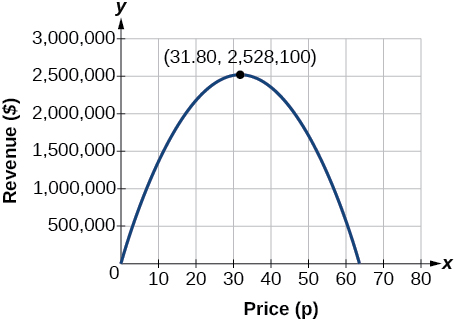
A ball is thrown upward from the top of a 40 foot high building at a speed of 80 feet per second. The ball’s height above ground can be modeled by the equation \(H(t)=−16t^2+80t+40\).
When does the ball reach the maximum height?
What is the maximum height of the ball?
When does the ball hit the ground?
The ball reaches the maximum height at the vertex of the parabola.
\[\begin{align} h &= −\dfrac{80}{2(−16)} \\ &=\dfrac{80}{32} \\ &=\dfrac{5}{2} \\ & =2.5 \end{align}\]
The ball reaches a maximum height after 2.5 seconds.
To find the maximum height, find the y-coordinate of the vertex of the parabola.
\[\begin{align} k &=H(−\dfrac{b}{2a}) \\ &=H(2.5) \\ &=−16(2.5)^2+80(2.5)+40 \\ &=140 \end{align}\]
The ball reaches a maximum height of 140 feet.
To find when the ball hits the ground, we need to determine when the height is zero, \(H(t)=0\).
We use the quadratic formula.
\[\begin{align} t & =\dfrac{−80±\sqrt{80^2−4(−16)(40)}}{2(−16)} \\ & = \dfrac{−80±\sqrt{8960}}{−32} \end{align} \]
Because the square root does not simplify nicely, we can use a calculator to approximate the values of the solutions.
\[t=\dfrac{−80-\sqrt{8960}}{−32} ≈5.458 \text{ or }t=\dfrac{−80+\sqrt{8960}}{−32} ≈−0.458 \]
The second answer is outside the reasonable domain of our model, so we conclude the ball will hit the ground after about 5.458 seconds. See Figure \(\PageIndex{16}\).
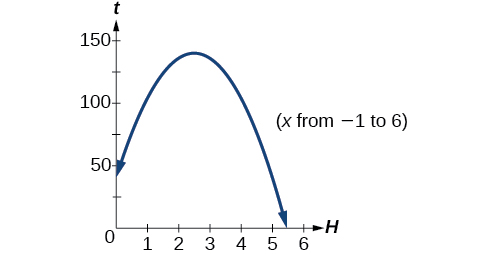
A ball is thrown into the air, and the following data is collected where x represents the time in seconds after the ball is thrown up and y represents the height in meters of the ball. We can use desmos to create a quadratic model that fits the given data.
| \(x\) | 0 | 1 | 2 | 3 | 4 |
|---|---|---|---|---|---|
| \(y\) | 1.5 | 16.6 | 21.9 | 17.4 | 3.1 |
On desmos, type the data into a table with the x-values in the first column and the y-values in the second column. Then, to tell desmos to compute a quadratic model, type in y1 ~ a x12 + b x1 + c. You will get a result that looks like this:
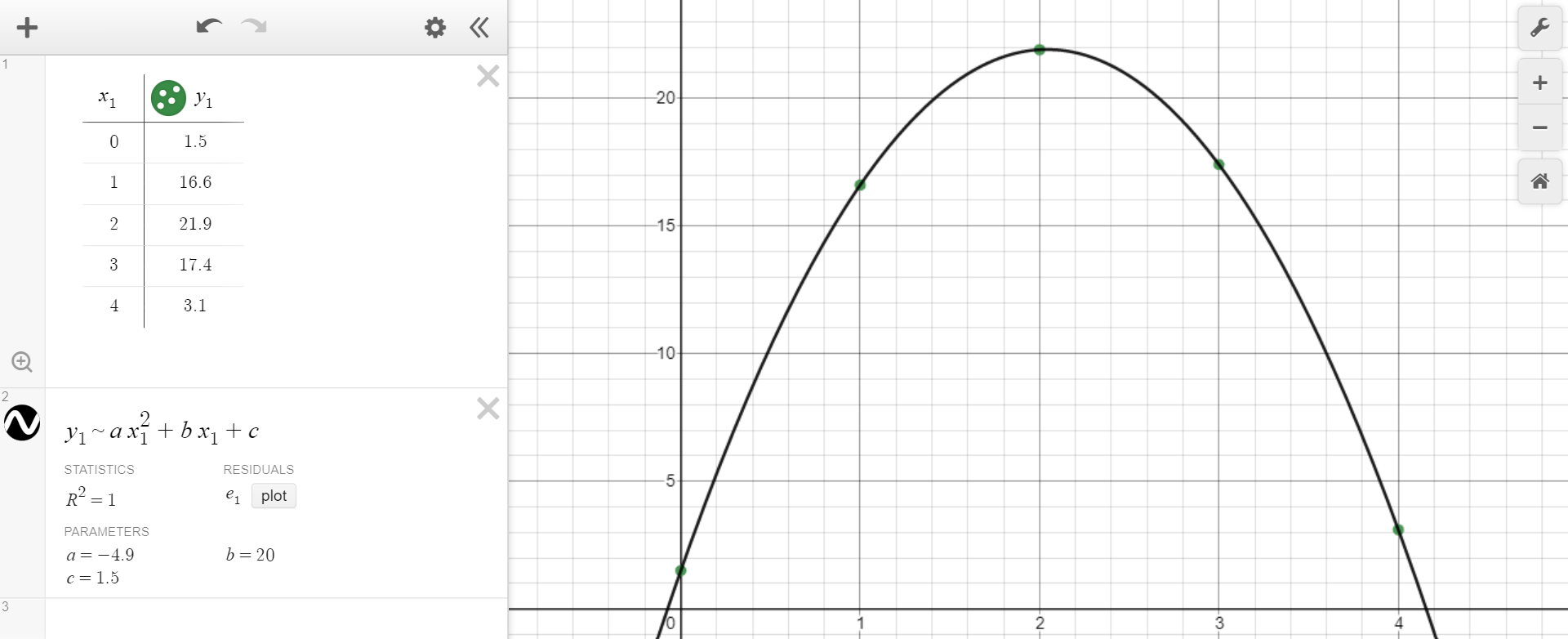
You can go to this problem in desmos by clicking https://www.desmos.com/calculator/u8ytorpnhk. Looking at the results, the quadratic model that fits the data is \[y = -4.9 x^2 + 20 x + 1.5\]


